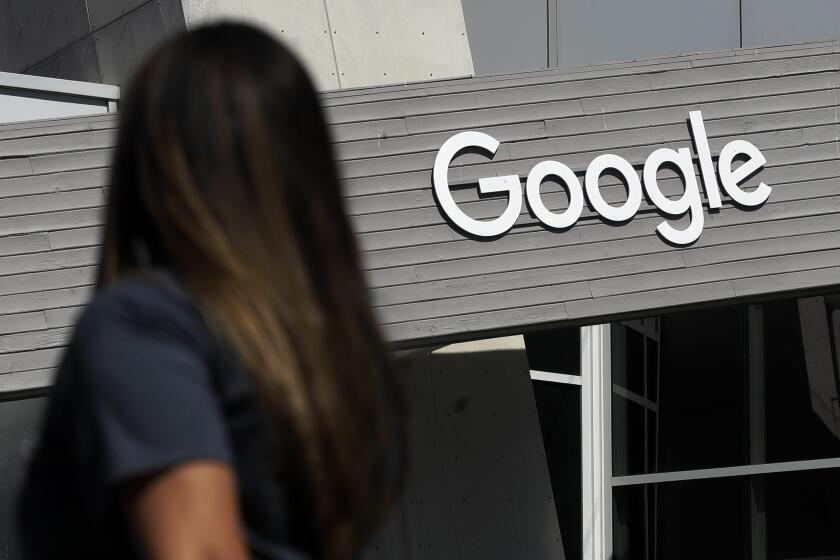Sick of high gas prices? Then it’s time to talk climate action

- Share via
Let’s start by getting something out of the way: The skyrocketing gas prices plaguing Californians are not caused by climate policy.
Yes, the state has clamped down on hydraulic fracking, raised the gas tax and required fossil fuel companies to pay for their planet-warming pollution. And yes, President Biden has worked to limit oil and natural gas leasing on federal lands.
But while the petroleum price surge has been caused by Russia’s invasion of Ukraine — and a continuing economic recovery from the COVID-19 pandemic — it could be a key moment for efforts to fight the climate crisis, in California and nationwide.
High gas prices could accelerate the shift to electric cars, slashing emissions while also dealing a blow to Russian President Vladimir Putin. Congress could offer generous financial assistance to make sure that low-income families can afford to go electric and don’t get stuck paying for ever-pricier gasoline.
And the Golden State could take steps to ensure that electricity — increasingly generated by solar panels and wind turbines — doesn’t get so expensive that residents decline to make the switch from oil.
Will any of that actually happen? It’s hard to say, but crisis creates opportunity. If there were ever a moment for America to break through its political logjam on climate policy and start taking dramatic steps to phase out fossil fuels, this might be it, experts say.
“For the first time, there is an option for people who need to drive that is not dependent on the cooperation of the Saudi regime and the Russian government,” said Michael Wara, director of the climate and energy policy program at Stanford University’s Woods Institute for the Environment. “We need to get that option into as many people’s hands as possible.”
Russia’s invasion is yet another reason to switch from fossil fuels to clean energy, experts say.
Half a century after the Arab oil embargo spurred calls for energy independence, the United States is the world’s largest producer of oil and natural gas. But American consumers are still very much subject to the whims of global markets and geopolitics.
Look no further than Biden’s decision this week to pressure Putin by cutting off imports of Russian oil, natural gas and coal. The move was expected to further drive up gasoline prices — which were already averaging $4.25 a gallon nationwide and $5.57 in California on Wednesday.
“The only way to not be vulnerable to the price of oil is to buy less oil,” Wara said.

The U.S. won’t be able to shut off the spigot overnight — and in the short term, more oil and natural gas production could reduce European demand for Russian exports and help keep prices from rising further. A report this week from research firm Rhodium Group found that the climate consequences would be small, with a temporary increase in global emissions of less than 0.1%.
In California, meanwhile, Gov. Gavin Newsom used his State of the State speech Tuesday to ask lawmakers to approve gas tax rebates for Golden State residents to blunt the effect of rising prices. But he held fast to his climate commitments, which include ending the sale of oil-powered vehicles by 2035 and spending billions of dollars to help Californians ditch gasoline.
“We won’t be ramping up [oil] production, but rather doing everything we can to accelerate on the clean energy and clean fuels side,” said Lauren Sanchez, Newsom’s senior climate advisor. “The geopolitical situation has only made that more urgent.”
Toward a more sustainable California
Get Boiling Point, our newsletter exploring climate change, energy and the environment, and become part of the conversation — and the solution.
You may occasionally receive promotional content from the Los Angeles Times.
Looking beyond California too, the stars appear to be aligning for a dramatic energy transformation.
The auto industry has begun to invest tens of billions of dollars in cleaner cars, with General Motors planning 30 electric vehicle models by 2025 and Ford staking much of its future on the F-150 Lightning electric pickup truck. The bipartisan infrastructure bill signed by Biden in November included $7.5 billion to help build out a national network of half a million electric vehicle chargers.
None of that will be enough to cut global carbon emissions nearly in half by 2030, which scientists say is needed to avoid the worst consequences of a warming planet — consequences that already include deadlier and more destructive fires, heat waves and droughts.
But additional federal policies — such as the clean energy provisions of Biden’s “Build Back Better” legislation — could speed the transition away from fossil fuels while helping low-income families replace their petroleum-powered cars with electric vehicles.
Rhodium Group’s report noted that ambitious climate measures — including federal grants and tax credits such as those in Build Back Better — could reduce the amount that American homes and businesses spend on oil products by as much as 24% by 2030.
It’s a strategy that revolves around making solar and wind power, electric vehicles and other climate-friendly technologies more affordable, rather than raising the cost of fossil fuels, said Trevor Houser, who leads Rhodium’s energy and climate practice.
“While it is not a panacea for the current [geopolitical] crisis, making those investments in clean energy today will make both the U.S. and Europe more protected over the medium term, and ensure we’re not in the position again,” Houser said.

The president made a similar case Tuesday, while announcing the ban on Russian oil imports.
“Loosening environmental regulations or pulling back clean energy investment won’t lower energy prices,” Biden said. “But transforming our economy to run on electric vehicles powered by clean energy, with tax credits to help American families winterize their homes and use less energy? That will help.... It will mean that no one has to worry about the price” of gas.
Cars and trucks are America’s largest source of emissions, with transportation accounting for nearly 40% of climate pollution in California and 28% nationwide.
But filling up at the gas pump isn’t the only place that energy prices and climate policy collide for many Americans. About half of U.S. homes use another fossil fuel, natural gas, for space heating, water heating and cooking.
Dozens of California cities have banned or discouraged gas hookups in new buildings, hoping to spur construction of all-electric homes with electric heat pumps and induction stoves. State officials are pursuing a similar strategy — as is the European Union, which set a target this week of rolling out 10 million heat pumps in the next five years, to reduce dependence on Russian gas.
California sparked a national push to ban gas lines into homes. Its success hinges on persuading home cooks the gas stove is obsolete.
But to make it all work — a future dominated by electric cars and electric heating, powered by solar panels and wind turbines — electricity will need to be affordable. And for the last few years, California has been moving in the wrong direction.
Electric rates have been rising faster than inflation, and state officials have projected they’ll keep rising — by around 4% annually — as utility companies spend billions more to stop their equipment from sparking fires. It’s a problem that could derail California’s climate plans, said Matthew Freedman, a staff attorney at the Utility Reform Network, a ratepayer watchdog group.
“We want to make it really cheap and attractive for people to electrify, because fundamentally this is a customer-level decision,” Freedman said. “It’s hard to force somebody to electrify their home. You can’t force somebody to buy an electric vehicle.”
Although solar and wind are now some of the world’s cheapest power sources, the electric rates paid by Californians cover all sorts of costs beyond just the price of power. For customers of the state’s three big monopoly utility companies — Southern California Edison, Pacific Gas & Electric and San Diego Gas & Electric — electric rates cover rooftop solar incentives, discounts for low-income homes, electric vehicle charging infrastructure and the costs of hardening the power grid to lower the risk of wildfire ignitions.

The Legislature could help keep electricity bills affordable by removing some of those expenditures from utility rates and instead paying for them directly out of the state budget, with tax dollars. In addition to supporting the clean energy transition, that could ease the financial burden of climate policy on low-income households, which can least afford to pay higher electricity bills.
“It might not be rates going down, but it would be rates going up by a smaller amount,” Freedman said.
Support our journalism
Your support helps us deliver the news that matters most. Subscribe to the Los Angeles Times.
High oil prices could also derail California’s climate plans, even as they underscore the urgency of phasing out fossil fuels.
Climate initiatives play a relatively small role in California’s gasoline prices. The state’s cap-and-trade program — which requires oil refineries and other polluters to pay for their emissions — currently adds about 22 cents a gallon, with the Low Carbon Fuel Standard program adding 15 cents, said Severin Borenstein, an energy economist at UC Berkeley.
The recent gas tax increase, which was approved by voters in 2018 and pays for transportation projects such as road and bridge repairs, means Californians pay an additional 28 cents more than drivers in other states, per Borenstein’s calculations. An additional 10-cent increase comes from a requirement that refineries produce a special gas blend that reduces smog-forming pollution.
But it’s easy for unhappy drivers to blame climate policy — and sticker shock at the pump “tends to have this outsize effect on what people perceive as their standard of living,” Borenstein said. Even though housing and medical costs are far more expensive for most families, “the political reality is that high gas prices are — I hate to say unacceptable, but politically extremely unpopular.”
That means keeping gas prices under control is key to avoiding a political backlash that could derail California’s climate agenda, Borenstein said.
With little control over global oil prices, state officials should investigate a “mystery gasoline surcharge” that he’s been writing about for several years, Borenstein said. By his calculation, Californians paid 31 cents more a gallon than drivers in other states last year, even after accounting for higher taxes, environmental fees and the state’s cleaner-burning gas formulation.
But if Californians want to avoid truly dramatic price shocks? There’s only one good long-term option, Borenstein said.
“Getting off oil will not only save us exposure to these sorts of price spikes, but it will help to undermine the finances of not just Russia but Saudi Arabia, Iran, Venezuela and all sorts of autocratic regimes,” he said. “It’s ethical in the climate change sense. But it’s also more ethical in the democracy and freedom and human welfare sense.”
More to Read
Inside the business of entertainment
The Wide Shot brings you news, analysis and insights on everything from streaming wars to production — and what it all means for the future.
You may occasionally receive promotional content from the Los Angeles Times.













